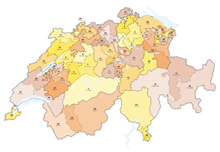1899 Swiss federal election
Federal elections were held in Switzerland on 26 October 1899. The Free Democratic Party retained its majority in the National Council.[1]
.svg.png) |
|---|
| This article is part of a series on the politics and government of Switzerland |
|
|

The 52 electoral districts
Electoral system
The 147 members of the National Council were elected in 52 single- and multi-member constituencies using a three-round system. Candidates had to receive a majority in the first or second round to be elected; if it went to a third round, only a plurality was required. Voters could cast as many votes as there were seats in their constituency.[2] There was one seat for every 20,000 citizens, with seats allocated to cantons in proportion to their population.[2]
Results
Voter turnout was highest in Schaffhausen (where voting was compulsory) at 86.4% and lowest in Obwalden at 21.3%.
| Party | Votes | % | Seats | +/– |
|---|---|---|---|---|
| Free Democratic Party | 183,216 | 49.7 | 84 | –2 |
| Catholic People's Party | 76,845 | 20.8 | 32 | +2 |
| Liberal Centre | 51,764 | 14.1 | 20 | –1 |
| Social Democratic Party | 35,488 | 9.6 | 4 | +2 |
| Democratic Group | 18,003 | 4.9 | 7 | –1 |
| Others | 3,409 | 0.9 | 0 | 0 |
| Invalid/blank votes | 33,015 | – | – | – |
| Total | 401,750 | 100 | 147 | 0 |
| Registered voters/turnout | 737,696 | 54.5 | – | – |
| Source: Mackie & Rose,[3] BFS (seats) | ||||
gollark: &sys eval 5
gollark: &admin
gollark: television < carrier pigeons delivering USB sticks containing webm files
gollark: heresy.
gollark: HMM, You like SP ORT?!?
References
- Elections to the National Council 1848–1917: Distribution of seats by party or political orientation Archived 2015-09-23 at the Wayback Machine BFS
- Dieter Nohlen & Philip Stöver (2010) Elections in Europe: A data handbook, p1886 ISBN 9783832956097
- Thomas T Mackie & Richard Rose (1991) The International Almanac of Electoral History, Macmillan
This article is issued from Wikipedia. The text is licensed under Creative Commons - Attribution - Sharealike. Additional terms may apply for the media files.